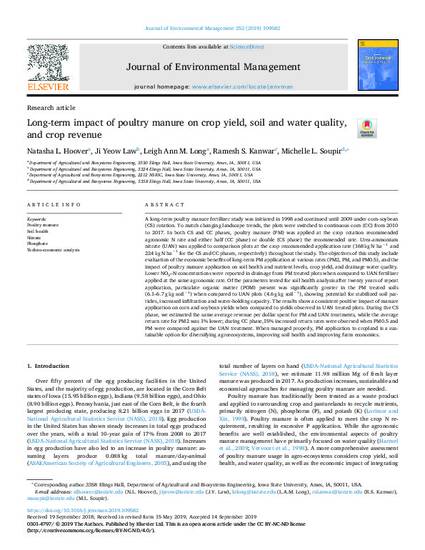
A long-term poultry manure fertilizer study was initiated in 1998 and continued until 2009 under corn-soybean (CS) rotation. To match changing landscape trends, the plots were switched to continuous corn (CC) from 2010 to 2017. In both CS and CC phases, poultry manure (PM) was applied at the crop rotation recommended agronomic N rate and either half (CC phase) or double (CS phase) the recommended rate. Urea-ammonium nitrate (UAN) was applied to comparison plots at the crop recommended application rate (168 kg N ha−1 and 224 kg N ha−1 for the CS and CC phases, respectively) throughout the study. The objectives of this study include evaluation of the economic benefits of long-term PM application at various rates (PM2, PM, and PM0.5), and the impact of poultry manure application on soil health and nutrient levels, crop yield, and drainage water quality. Lower NO3–N concentrations were reported in drainage from PM treated plots when compared to UAN fertilizer applied at the same agronomic rate. Of the parameters tested for soil health analysis after twenty years of repeat application, particulate organic matter (POM) present was significantly greater in the PM treated soils (6.1–6.7 g kg soil−1) when compared to UAN plots (4.6 g kg soil−1), showing potential for stabilized soil particles, increased infiltration and water-holding capacity. The results show a consistent positive impact of manure application on corn and soybean yields when compared to yields observed in UAN treated plots. During the CS phase, we estimated the same average revenue per dollar spent for PM and UAN treatments, while the average return rate for PM2 was 1% lower; during CC phase,15% increased return rates were observed when PM0.5 and PM were compared against the UAN treatment. When managed properly, PM application to cropland is a sustainable option for diversifying agroecosystems, improving soil health and improving farm economics.
Available at: http://works.bepress.com/rskanwar/165/

This article is published as Hoover, Natasha L., Ji Yeow Law, Leigh Ann M. Long, Ramesh S. Kanwar, and Michelle L. Soupir. "Long-term impact of poultry manure on crop yield, soil and water quality, and crop revenue." Journal of Environmental Management 252 (2019): 109582. DOI: 10.1016/j.jenvman.2019.109582. Posted with permission.